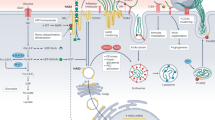Abstract
Hyaluronan is one of the most influential components of the extracellular matrix. It is involved in the regulation of normal tissue function and architecture, while its metabolism is perturbed in a multitude of human diseases like inflammation, cancer, and viral infection. Given the implication of hyaluronan in a vast array of diseases, we describe here assays that can be utilized to study the quantity, size, subcellular localization, and binding capacity of hyaluronan by cells as well as its interactions with its major cellular receptor, CD44. Hopefully, these protocols will provide researchers with useful tools to study the complex hyaluronan biology.
Access this chapter
Tax calculation will be finalised at checkout
Purchases are for personal use only
Similar content being viewed by others
References
Caon I, Parnigoni A, Viola M et al (2021) Cell energy metabolism and Hyaluronan synthesis. J Histochem Cytochem 69(1):35–47
Karalis T, Skandalis SS (2022) Hyaluronan network: a driving force in cancer progression. Am J Physiol Cell Physiol 323:C145
Skandalis SS, Karalis T, Heldin P (2020) Intracellular hyaluronan: importance for cellular functions. Semin Cancer Biol 62:20–30
Camenisch TD, Spicer AP, Brehm-Gibson T et al (2000) Disruption of hyaluronan synthase-2 abrogates normal cardiac morphogenesis and hyaluronan-mediated transformation of epithelium to mesenchyme. J Clin Invest 106(3):349–360
Skandalis SS, Karalis TT, Chatzopoulos A et al (2019) Hyaluronan-CD44 axis orchestrates cancer stem cell functions. Cell Signal 63:109377
Heldin P, Kolliopoulos C, Lin CY et al (2020) Involvement of hyaluronan and CD44 in cancer and viral infections. Cell Signal 65:109427
Heldin P, Basu K, Kozlova I et al (2014) HAS2 and CD44 in breast tumorigenesis. Adv Cancer Res 123:211–229
Tolg C, Messam BJ, McCarthy JB et al (2021) Hyaluronan functions in wound repair that are captured to fuel breast cancer progression. Biomol Ther 11(11):1551
Tengblad A (1979) Affinity chromatography on immobilized hyaluronate and its application to the isolation of hyaluronate binding properties from cartilage. Biochim Biophys Acta 578(2):281–289
Jalkanen S, Bargatze RF, de los Toyos JS et al (1987) Lymphocyte recognition of high endothelium: antibodies to distinct epitopes of an 85-95-kD glycoprotein antigen differentially inhibit lymphocyte binding to lymph node, mucosal, or synovial endothelial cells. J Cell Biol 105(2):983–990
Culty M, Miyake K, Kincade PW et al (1990) The hyaluronate receptor is a member of the CD44 (H-CAM) family of cell surface glycoproteins. J Cell Biol 111(6 Pt 1):2765–2774
Chanmee T, Ontong P, Mochizuki N et al (2014) Excessive hyaluronan production promotes acquisition of cancer stem cell signatures through the coordinated regulation of twist and the transforming growth factor beta (TGF-beta)-snail signaling axis. J Biol Chem 289(38):26038–26056
PEGNAC_HA_Size; NHLBI award number PO1HL107147
Karalis TT, Heldin P, Vynios DH et al (2019) Tumor-suppressive functions of 4-MU on breast cancer cells of different ER status: regulation of hyaluronan/HAS2/CD44 and specific matrix effectors. Matrix Biol 78-79:118–138
Nagy N, Kuipers HF, Frymoyer AR et al (2015) 4-methylumbelliferone treatment and hyaluronan inhibition as a therapeutic strategy in inflammation, autoimmunity, and cancer. Front Immunol 6:123
Jalkanen ST, Bargatze RF, Herron LR et al (1986) A lymphoid cell surface glycoprotein involved in endothelial cell recognition and lymphocyte homing in man. Eur J Immunol 16(10):1195–1202
Picker LJ, De los Toyos J, Telen MJ et al (1989) Monoclonal antibodies against the CD44 [in(Lu)-related p80], and Pgp-1 antigens in man recognize the Hermes class of lymphocyte homing receptors. J Immunol 142(6):2046–2051
Author information
Authors and Affiliations
Corresponding author
Editor information
Editors and Affiliations
Rights and permissions
Copyright information
© 2023 The Author(s), under exclusive license to Springer Science+Business Media, LLC, part of Springer Nature
About this protocol
Cite this protocol
Karalis, T., Heldin, P., Skandalis, S.S. (2023). In Vitro Investigation of Hyaluronan/CD44 Network. In: Karamanos, N.K. (eds) Proteoglycans. Methods in Molecular Biology, vol 2619. Humana, New York, NY. https://doi.org/10.1007/978-1-0716-2946-8_13
Download citation
DOI: https://doi.org/10.1007/978-1-0716-2946-8_13
Published:
Publisher Name: Humana, New York, NY
Print ISBN: 978-1-0716-2945-1
Online ISBN: 978-1-0716-2946-8
eBook Packages: Springer Protocols




